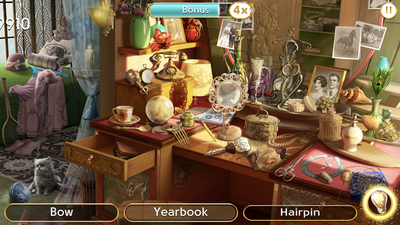June's Journey
Hidden object games moved from their old dwellings in children’s sections of newspapers to new homes on touchscreens in the early iOS era, and every generation of the operating system sees a new app iterate over the same mechanics. More of the same isn’t always bad — it’s nice to have new apps with refreshed graphics to replace aging legacy games that are no longer supported — but nevertheless, newcomers must somehow justify their existence. June’s Journey had a promising plan to do so: wrap classic hidden object gameplay in a mystery story and toss in some city building-esque filler as a bonus. But it ultimately commits too many sins of other free-to-play, casual games to remain enjoyable, and a poorly executed progression system subjects players to numbing repetition.

The setting is fairly simple. June is a British WWI veteran nurse with a knack for quick thinking and insightful observations. Upon learning that her sister and brother-in-law were murdered, purportedly in a murder-suicide by her brother-in-law’s own hand, she travels to New York to find answers. Your mission quite literally becomes June’s: find hidden clues which steadily reveal more of the mystery, bringing you closer to the only answers that will make sense of the violence. As an aside, the family estate has fallen into some disrepair, so coins and resources gained from completing levels can be put towards decorating and renovating dilapidated structures.
The progression system is superficial, to say the least. Each hidden object scene can only be accessed after the player reaches the corresponding player level. Player level increases with flowers, a strange disguise for a typical XP/leveling system. But instead of earning flowers through playing levels and finding objects (which one could argue is the whole point), flowers are rewarded for buying decorations and upgrading buildings on the estate. This creates an illogical and contrived system of currencies: playing levels rewards coins and materials, which in turn are used to buy decorations and building upgrades, which in turn reward flowers that sum to higher player levels, which in turn unlock new levels one-by-one. If that sounds unnecessarily complicated, it’s because it is. Very little is gained from each currency exchange, and binding a player’s story progression to the number of trellises built and bushes planted can only be seen as a ploy to make content last longer.
The joy of a hidden object game is in finding things. There’s nothing wrong with adding extra elements to the gameplay; a good story is a boon to any game, and rewarding players with an increasingly sprawling and beautiful estate to mark their time investment is quite nice. But when grinding for levels and resources reduces finding hidden objects to memorizing where on the screen to tap, there can be no arguing that June’s Journey lost sight of its core gameplay which should have remained its soul.